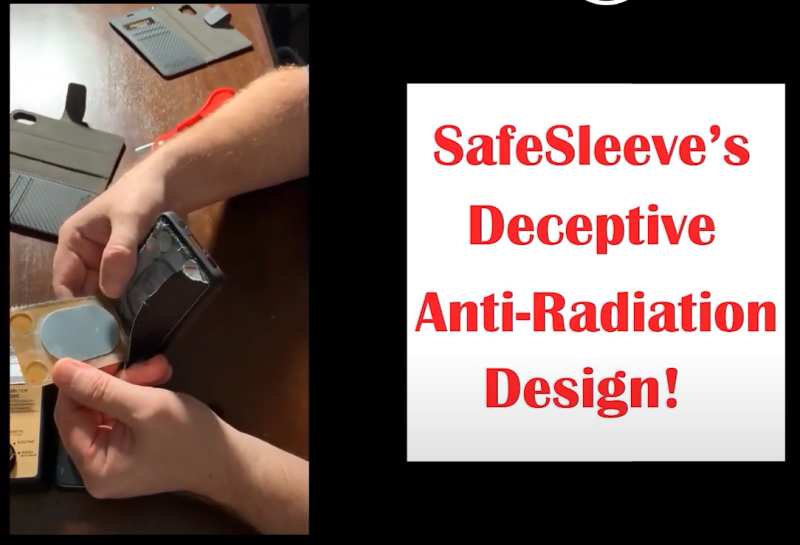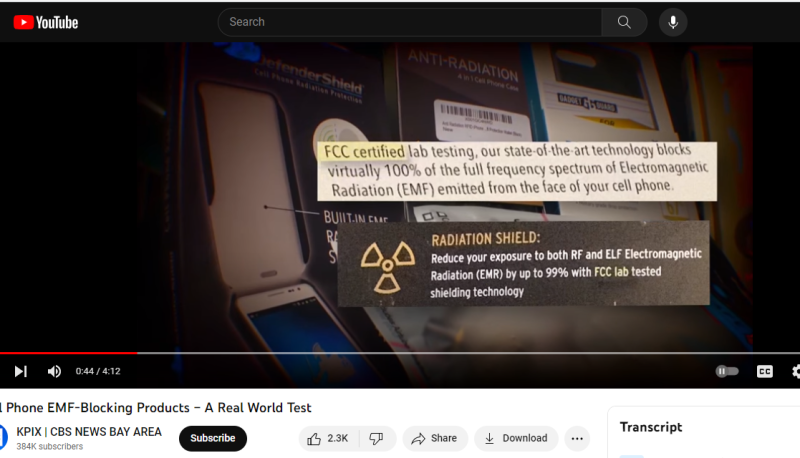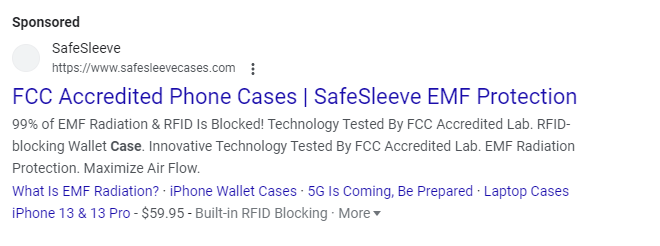In today’s hyper-connected world, concerns about cell phone radiation have become increasingly common. Many consumers, aware of potential health risks associated with wireless radiation, seek out protective products claiming to reduce or shield radiation exposure. SafeSleeve is one such company, advertising smartphone cases and other accessories marketed as “anti-radiation” solutions. At face value, these products seem to promise peace of mind. However, as the video transcript you’ll see below reveals, SafeSleeve’s design and marketing might be putting users at even greater risk rather than protecting them.
The video transcript highlights five main deceptive practices associated with SafeSleeve cases. This blog post will thoroughly dissect each one, adding further context, background information, and references to help you make an informed decision about how best to protect yourself from cell phone radiation. Given the significant implications for public health, it is crucial for readers to understand why these issues matter and to pay close attention to how consumer products are marketed—and tested—for safety.
Ultimately, protecting yourself from excessive radiofrequency (RF) radiation is about more than just buying a single product. It’s about adopting a comprehensive lifestyle change—one informed by accurate science and free from misleading claims. Read on to learn about the pitfalls of certain “anti-radiation” solutions, how to spot deceptive marketing strategies, and what practical steps you can take to safeguard your health.
Analysis and Elaboration
Below, we break down the five core issues highlighted in the video and provide additional context, references, and commentary. This ensures you have a comprehensive understanding of why these design and marketing flaws are so concerning.
1. Interference With the Phone’s Antenna (Leading to Higher Radiation Emissions)

How SafeSleeve’s Metal Plate Causes Problems
One of the most alarming revelations in the transcript is that SafeSleeve cases include a large piece of metal (and magnets) that sits directly behind the phone. This metal plate can obstruct the phone’s antenna. When a cell phone’s antenna is blocked, the device compensates by increasing its power output, resulting in higher levels of radiation being emitted.
Why this matters:
- Signal Compensation: Cell phones are designed to maintain a stable connection to the nearest cell tower. If the signal is blocked or weakened, the phone will boost its transmit power to reestablish a strong link.
- User Exposure: Higher transmit power translates to higher Specific Absorption Rate (SAR), meaning the body could absorb more RF radiation.
- Regulatory Warnings: Both the FCC and FTC have explicitly warned about such scams, noting that any product that forces a phone to work harder to send and receive signals can increase user radiation exposure.
Supporting Studies and Observations
- A 2012 Consumer Reports article highlighted how any device that blocks a phone’s antenna can lead to increased radiation output.
- The Federal Trade Commission also advises that so-called “shields” can do more harm than good if they interfere with the phone’s normal operation.
Takeaway: If a product’s design obstructs the antenna, it could do precisely the opposite of what it promises—raising rather than lowering your overall radiation exposure.
2. Misleading Claims of FCC Testing

SafeSleeve promotes the idea that its cases are “FCC certified,” but the transcript clarifies an important distinction:
- Only the raw shielding material was tested (using a signal generator), not the actual phone-in-case configuration.
- The testing method is not reflective of real-world phone usage, where signal strength fluctuates and the device dynamically changes power levels.

Understanding FCC Certification
The FCC requires specific testing procedures to ensure phones meet its SAR limits. However, these tests:
- Are done with the phone itself, not just a piece of material in isolation.
- Replicate real-world use, including positions near the head and torso.
Why the Distinction Matters:
- A piece of material might, in theory, block or absorb some radiation in a controlled lab environment, but in actual use, the phone is constantly adjusting its power.
- Misleading advertising can give users a false sense of security, leading them to behave in ways that increase risk (e.g., carrying the phone closer to their body for longer periods).

3. The Trefoil Symbol (Radioactive Symbol) as a Scare Tactic
Another red flag is the use of the trefoil symbol on SafeSleeve’s packaging. This iconic symbol is meant to warn about ionizing radiation, such as that emitted by nuclear materials. Cell phones, however, emit non-ionizing radiation (in the radiofrequency/microwave range).
Why This is Misleading
- Ionizing vs. Non-Ionizing: While both can be harmful, ionizing radiation (like X-rays, gamma rays) can cause immediate and direct cellular damage leading to acute conditions. Non-ionizing radiation’s effects typically manifest over a longer period if at all.
- Global Recognition: The trefoil symbol is internationally recognized to communicate urgent danger, crossing language barriers. Using it to sell phone cases waters down this critical warning symbol, potentially causing confusion in situations where the symbol’s recognition is vital to public safety.
Moral and Ethical Considerations
- Exploiting fears around “radiation” can be profitable, but it’s ethically questionable because it creates undue panic while misrepresenting the nature of the health threat.
- It also undermines the seriousness of ionizing radiation warnings in environments where they are truly needed (e.g., hospitals, nuclear facilities).
4. Demonstrations That Don’t Test Actual RF Microwave Emissions
The transcript exposes how SafeSleeve’s marketing materials use a TriField Meter but fail to switch it to the RF/microwave setting, the very frequency band cell phones use. Instead, they demonstrate minimal changes in electric and magnetic fields, which is not where the main concern lies.
Significance of Proper Testing
- Cell Phones Primarily Emit RF: The bulk of a phone’s radiation is in the radiofrequency spectrum, specifically microwaves.
- Sleight-of-Hand: By not demonstrating the meter on the correct setting, the viewer is misled into thinking the product is blocking “radiation,” but it’s not actually measuring the phone’s primary emissions.
- Consumer Confusion: This tactic preys on the fact that many consumers won’t know the difference between electric field, magnetic field, and RF field settings on a meter.
5. Pointless “Shielding” for Laptops and Tablets
Lastly, the transcript critiques SafeSleeve’s tablet and laptop cases. The crux of the issue: modern laptops and tablets use wireless connections, meaning transmitters are located throughout the device—not just the bottom or rear.
Ineffectiveness of Partial Shielding
- If you only shield the bottom of a laptop, the rest of the device (including the top, sides, and screen edges) can still emit radiation.
- Reflected Radiation: Shielding one side can redirect or reflect RF emissions in unpredictable ways, potentially increasing exposure to other parts of the body.
- False Sense of Security: Users may feel protected and hold the device closer or use it for longer periods, ironically heightening their exposure.
Historical Context
- As mentioned in the transcript, RF Safe pioneered laptop shields decades ago when laptops were typically wired. Once Wi-Fi became the norm, they recognized the limitations of partial shielding and ceased production—something SafeSleeve apparently never did.
Additional Context and Why It Matters
A. Global Regulatory Environment
Regulatory bodies like the FCC (in the U.S.) set SAR limits and have guidelines for how devices should be tested. However, these agencies also warn consumers about products that claim to “block” or “reduce” radiation without credible evidence or whose design inadvertently boosts emissions.
- FTC Warnings: The Federal Trade Commission regularly updates its consumer alerts, cautioning against untested “radiation shields.”
- International Agencies: In many countries, consumer protection agencies have begun investigating claims related to phone radiation shielding, but legislation and enforcement can vary widely.
B. The Importance of Honest Marketing
Deceptive marketing around “anti-radiation” products can have severe consequences. When consumers believe they are protected, they may:
- Keep phones closer to their bodies (e.g., in a pocket).
- Use phones more frequently or for longer durations.
- Forego safer usage habits, such as using the speakerphone or a headset, because they think they’re protected already.
C. Steps Toward Real RF Safety
- Lifestyle Changes: As pointed out in the transcript, limiting exposure starts with how you use your phone—brief calls, speakerphone, texting instead of calling, and keeping devices out of your pocket when possible.
- RF-Safe Accessories: If you do use a shielding case, ensure it’s properly tested with an actual phone in real-world conditions. Look for transparent testing reports.
- Official Testing Protocols: Any claims of “FCC-certified” or “FCC-tested” should align with actual FCC compliance testing for phones, not just raw materials tested in isolation.
Detailed Look at Each Deceptive Tactic
Below is a more structured overview of the five main tactics described in the transcript, offering a succinct summary.
1. “Shields” That Increase Radiation
- Problem: Metal plates block the antenna, forcing the phone to increase power.
- Consequence: Potentially higher SAR levels, contrary to the product’s stated goal.
2. Unrepresentative “FCC Testing”
- Problem: Only raw materials are tested, not the complete product with a phone.
- Consequence: Consumers are misled to believe the entire case design is sanctioned by the FCC.
3. Misuse of the Trefoil Symbol (Radiation Hazard)
- Problem: Conflates non-ionizing (cell phone) radiation with ionizing (nuclear) radiation.
- Consequence: Fear-mongering and ethical misuse of an international hazard symbol.
4. Improper Demonstrations Using a TriField Meter
- Problem: Demonstrations measure electric/magnetic fields, not the RF/microwave field.
- Consequence: Gives the false impression the product is blocking the radiation that matters most.
5. Shielding Products for Tablets/Laptops That Emit RF
- Problem: Shielding only part of a device with multiple transmitters is largely ineffective.
- Consequence: Users gain a false sense of security and may neglect safer usage habits.
Conclusion
Key Takeaways
- SafeSleeve’s design choices (particularly the metal backing) can cause phones to emit higher power, defeating the purpose of an “anti-radiation” product.
- Their testing claims rely on data from isolated material tests, not real-world phone usage scenarios.
- Fear-based marketing using the trefoil symbol is both deceptive and ethically problematic.
- Demonstrations that measure the wrong type of field (electric or magnetic instead of RF/microwave) are misleading consumers.
- Laptop/tablet shielding in a wireless context is far less effective than advertised.
Final Thoughts and Call to Action
Misleading “anti-radiation” products present a public health concern. They can dissuade individuals from taking truly effective measures to minimize RF exposure. It’s crucial to:
- Educate yourself on how phones and wireless devices actually operate.
- Look for transparent testing reports from credible laboratories that test complete products in real-world usage.
- Practice common-sense protective habits, such as using the speakerphone, texting instead of calling, or keeping your phone away from your body when not in use.
- Ask questions if a company’s marketing claims seem exaggerated. Genuine consumer protection means holding companies accountable for deceptive practices.
Where to Go From Here
- If you own a SafeSleeve or a similar “anti-radiation” product, reconsider how you use it. Check whether the company provides credible test data.
- Keep an eye out for regulatory warnings. Both the FCC and FTC periodically issue press releases about scam products or misleading marketing tactics.
- Share this information with friends and family who may also be concerned about RF exposure. Responsible consumer behavior starts with awareness and education.
In a world that depends increasingly on wireless technology, awareness is our best line of defense. By staying informed and critically evaluating products claiming to offer guaranteed protection, you can better minimize your exposure and prioritize your health.
Remember, there’s no single silver-bullet solution for avoiding cell phone radiation. A holistic approach—from mindful usage to understanding real science—is the most reliable way to stay safe.
Additional Resources
- Federal Trade Commission (FTC): Cell Phone Radiation Scams
- Federal Communications Commission (FCC): Wireless Devices and Health Concerns
- World Health Organization (WHO): Electromagnetic Fields (EMF)







